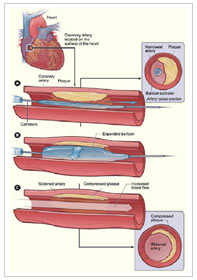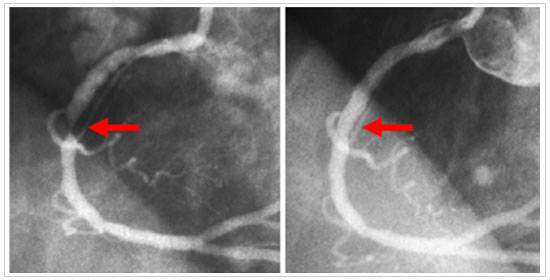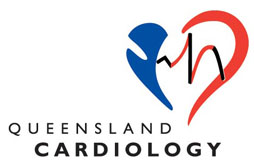Coronary Angioplasty and Stenting
What is Angioplasty and Stenting?
Angioplasty and stenting is often used instead of surgery to treat narrowed or blocked coronary arteries.
How is it done?
The procedure begins with an injection of local anaesthetic in the groin/arm, a fine tube (catheter) is put into the artery in that location. The tube is passed into the coronary arteries. A series of pictures are taken using X-Rays and X-Ray dye. If any narrowing or blockages are found then a tube with a tiny wire is passed down the affected artery so that a sausage-shaped balloon can be passed over it and into the part that is narrowed or blocked.
To open up the artery, the balloon is blown up with fluid, which then presses against the cholesterol plaque. pushing it out of the way.
Most of the time, one or more stents are then placed in the artery to help keep the artery open. A stent is a metal tube or spring coil. This is passed into the diseased part of your artery using a balloon. The balloon is removed once the stent is in place.
The stent stays in for life. After the procedure, you will be given drugs which reduce your risk of blood clotting and the stent blocking.
While the catheter is in the artery, a number of additional mechanical devices may be used to complete the procedure. These include pressure wires and an Intravascular Ultrasound (IVUS).
If the heart becomes unstable during the procedure, an additional balloon device to stablise the heart may be required. This is called an intra-aortic balloon pump.
At the end of the procedure, the artery may be closed with a special plug to stop the bleeding.
Medication such as Clopidogrel (Plavix or Iscover) is used for up to four weeks and usually longer. A small daily dose of Aspirin may need to be taken for the rest of your life.
How do I prepare?







| Baseline Angiogram | After Angioplasty |
After the procedure
- You may have some bruising and soreness around the access site
- Do not drive for 24 hours after the procedure
- Do not lift objects over 5kg for 3-4 days after your procedure
- Notify your Doctor or present at the emergency department if you have any significant bleeding, pain or fevers
- Notify your Doctor if you have any significant chest pain or angina
- You will be required to spend a night in hospital following your procedure.
What are the risks?
In recommending this procedure your doctor has balanced the benefits and risks of the procedure against the benefits and risks of not proceeding. Your doctor believes there is a net benefit to you going ahead. This is a very complicated assessment. The risks are higher if you are having the procedure for a heart attack.
Common risks (more than 5%) –
- minor bruising at the puncture site
- the coronary artery can become narrowed or blocked again. Many factors can influence this and your doctor will discuss this with you
- loss of pulse in the arm after a radial artery (arm) procedure
- major bruising or swelling at the puncture site.
Uncommon risks (1-5%) –
- abnormal heart rhythm that continues for long time. This may need an electric shock to correct
- a heart attack
- surgical repair of the groin/arm puncture site or blood vessel.
If you have any further questions, please contact us at:
Queensland Cardiology
St Vincent’s Private Hospital Northside
North Medical Suites, Green Lifts Level 3,
627 Rode Road
Chermside Q 4032
(07) 3861 5522

